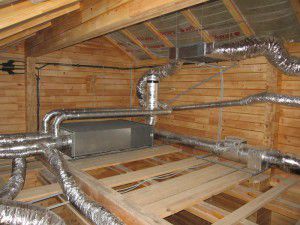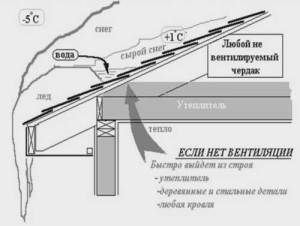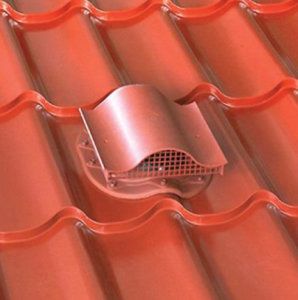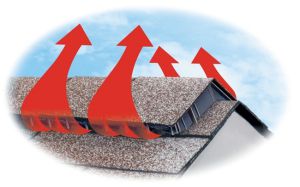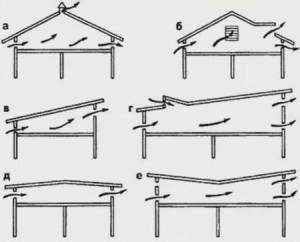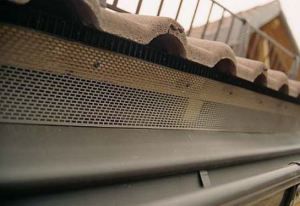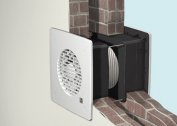Owners are often afraid to equip a cold attic ventilation in their private homes, guided by the following assumptions.
- Through the ventilation grilles of the attic, heat leaves the house. It is believed that the building will cool faster. But most often the problem is poor thermal insulation of walls or ceilings. By the way, through the poorly insulated ceiling, moist moist air enters the attic. What is his danger we will describe in the next chapter;
- Ventilation of the cold attic of a hip roof or tent is necessary only in the summer. According to many, ventilation grilles and windows in the attic are needed only for ventilation in the stuffiness. In fact, in winter the ceiling of an unheated and unventilated attic will turn into a cave overgrown with icy stalactites;
- It doesn’t matter what size ventilation ducts. The area of ventilation windows and vents in the attic must be carefully calculated. How to do it right - read on.
Attic ventilation in a private house is an essential element of thermoregulation. Properly organized, it allows you to save money on heating or cooling living space and save the structure itself intact. Particularly important is attic ventilation above the attic.
The attic in a private house needs ventilation both in winter and in summer.
So, in the hot season, a red-hot roof heats the air in the attic to 150 degrees. Most of this heat is given to the ceiling of the upper floor, the air conditioner has to work with increased load in order to eliminate excess heat. If there is no air conditioning, the owners are weary of hell and stuffiness.
In winter, air exchange is necessary to remove excess moisture. According to technical requirements, the temperature difference between the street and the attic should be 4 degrees or less. The temperature difference between the residential floor and the street contributes to the accumulation of condensate on the roof rafters. Moisture gradually freezes, creating entire cascades of icicles. In the thaw they melt and moisture drips onto the floor of the attic. The supporting structures of the roof and ceiling are destroyed. Mold develops on wooden rafters.
By the way, high-quality ventilation of the cold attic prevents the accumulation of snow and ice on the roof of the house.
What is attic ventilation?
Free air exchange between the under-roof space and the street is carried out through gaps and holes. The holes in the skates and under the roof overhang work most effectively. Located in this way, they use the pressure of the wind and heat coming from the ceiling of the house.
If the ventilation of a cold attic in a private house is properly equipped, in one hour the air double circulates the entire roof from the inside. The flow movement is directed from the bottom from the vents under the eaves up to the bottom plates with special holes. If the roof is insulated, a gap of up to 5 cm wide is left for free passage of air between the roofing material and the insulation.
The best hood is provided by a combination of products in the ridge and pitched elements mounted near the ridge. For tiled roofs, tiles are made with vents for air exchange.
And another way to ventilate attics in private homes is to install deflectors (ventilation turbines) that provide mechanical traction.The method is good for ventilating an insulated attic above the attic.
A small slope of the roof must also be considered when planning the ventilation of a cold attic. Outlets in the ridge can be covered with snow, so they are replaced by pipes whose height should be higher than the snow cover.
The most ancient way of ventilation is the ventilation window in the attic. To ensure excellent air exchange in a cold attic, a combination of products under the eaves, in the ridge and dormers is quite enough.
Ventilation of the cold attic of houses with a hip roof differs in that the house has no gables. Therefore, ventilation windows in the attic have nowhere to install. Thus, the cold attics under the hip roofs are ventilated using ridge and cornice vents.
More difficult is the ventilation of the attic above the attic. Here the vents are provided with slots in the roofing cake and mechanical means of traction. The ventilation outlet to the attic is hidden in the columns.
Attic ventilation through dormers
For attic ventilation, only dormer windows can be used without equipping a ventilation system and vents. This option is not very effective, because under the windows and above them the air may stagnate.
In order to improve air exchange and reduce the volume of stagnant places, the size of the auditory windows is 60 cm x 80 cm. They are mounted in opposite gables. First, wooden frames are made, attached by racks to the rafters. The roof material is attached to the frame. Windows look better with the same materials as the roof. As a decoration for the openings around the windows, the lining is well suited. The window box in the opening is installed last. All gaps between the window frame and the roof should be carefully closed.
Rules for placing ventilation windows:
- windows are placed at equal distances from the ridge, cornice and sides;
- there should be a distance of more than one meter between the windows;
- window design should harmoniously fit into the general view of the structure;
- in the window you can mount the ventilation grill for the attic, painting it in the tone of the roof.
Roof and Roof Products
Air vents are openings in a roof for ventilation of a cold or warm attic. Ventilations are ridge or cornice, depending on their location. Eaves are arranged on both sides of the eaves and are gaps between the roof and the wall about 2 cm wide. They are called slotted. If the vents are made in the form of holes, they are called point ones. The smaller the slope of the slopes, the more the diameter or width of the ducts is made, but not more than 2.5 centimeters.
Skate vents are made in the form of slots up to 5 cm wide or in the form of flyugs with gaps of up to 8 meters. Skate vents are also equipped in piece-covered roofs, for example, tiled. Special tiles with holes are placed one row from the ridge.
Outlets for the upper part of the roof are made in the form of aerators, tongs or retractable roof outlet. Skate aerators and pitched exits can be purchased with roofing material.
The souls - This is the only way to ventilate the attic without dormers.
Ventilation aerators
The roofing aerator is a modern and convenient type of products. It is a pipe top covered with a hat. Aerators remove steam, moisture and stagnant air, providing ventilation of a cold attic in a private house. Aerators are installed on the roof slopes, where the air movement is provided by the difference in temperature and pressure, replacing the ridge products. Aerators are continuous and point. Point aerators are equipped with fans and guarantee good air movement. Outwardly, they resemble fungi.
Continuous aerators are a plate along the ridge with holes.Being covered with a roof top, they are almost invisible and provide intensive air movement due to the large area of the holes.
Various types of aerators are created specifically for roofing from:
- shingles;
- flat roofing;
- cermets;
- ceramics.
Aerators are installed only where eaves are provided. There are other conditions for their installation:
- only roofs with a slope of 15 - 45 degrees are suitable;
- a distance of at least 30 cm is maintained from the chimney or wall;
- aerators peek out over a 25 cm cut from both ends of the ridge;
- point models are mounted no further than 50 cm from the ridge.
Calculation of attic ventilation
Those who decide to equip the attic ventilation with their own hands before starting work need to make calculations. Only the specialist can guarantee the best result. And for the most daring, we have prepared a hint:
The ratio of product area to attic area is 1: 500.
At 500 square meters. meters of attic area should be 1 square. meter vents. In extreme cases, you can be guided by a ratio of 1: 300, per 200 square meters. meters of attic should have a minimum of 0.4 square meters. meters of products. In the calculations, the area of true ventilation is taken into account, that is, even the width of the gratings, the edges of which violate the movement of air flows, is excluded.
Exceeding the product area is also undesirable, as well as a disadvantage. Snow and rain can get into too large openings, because these are the most vulnerable spots on the roof, which must be remembered.
The area of the hood (ridge and pitched gratings) should be 12 - 15% higher than the area of the inflow (cornice ducts).
DIY cold attic ventilation
Many owners are thinking about how to make the ventilation of the attic, after a few years of living in the house. The musty smell and dampness in the winter force to take up tools. We will talk about the construction of ventilation of any attic with our own hands.
With a gable roof, it is easiest to equip the attic ventilation with your own hands, having done vents in the gables. Pediments are usually made of wood and this greatly facilitates the work. Closed by a tree and wind overhangs on the sides of the roof. All slots need to be done evenly, providing airflow over the entire attic area.
There are no gaps in the stone gables, so you have to arm yourself with an instrument and drill two dormer windows. They are closed with grilles and mosquito nets.
When installing attic ventilation with your own hands, the placement of vents largely depends on the shape of the roof. Various options are proposed in the diagram above.
No need to worry about how to make attic ventilation possible if slate, tile or ondulin is used as roofing material. The wavy shape provides enough voids for the passage of air. And they lay the sheets on the crate with gaps through which the air flows. The metal tile, although it has a wavy shape, collects condensate when the temperature drops, so it is covered with a vapor barrier film from below.
A competent conclusion of ventilation to the attic is no less important than its installation. And special attention should be paid to pipe insulation.
Ventilation pipe insulation
Ventilation pipes must be insulated in the attic and above the roof level. This procedure is performed to avoid the accumulation of condensate, which will accumulate on the inner walls and drain down. Since the joints of the ventilation pipes are not made airtight, moisture will penetrate the supporting structures, ruin the finish and lead to the gradual destruction of the building. Yes, and the ventilation ducts themselves suffer from contact with moisture, if they are made of a galvanized pipe.
In winter, the ventilation duct lumen is covered with hoarfrost and literally in a month the standard 15 cm diameter pipe will completely close.
The appearance of condensation in ventilation ducts is inevitable: people exhale water vapor, wash dishes, bathe and wash. In this case, moisture is released into the air. Humidity of warm air in a residential building can reach 100%. Touching the cool surface of the ventilation shafts, water settles on it.
To prevent this process, and carry out the insulation of ventilation pipes in the attic. Here lies the boundary between the warm air of the house and the cold unheated attic.
The cheapest version of insulation: mineral wool. It does not burn, but when wet completely loses its qualities. It is easier to mount a corrugation with warming mineral wool.
Polyfoam in the form of special removable "shells" is very easy to install and inexpensive. But it burns perfectly, emitting toxic smoke, therefore it is not recommended for residential buildings.
The best materials for ventilation duct insulation: polyurethane foam, foamed polyethylene, polypropylene foam.
Professionals Recommendations
And, in the end, some important tips for those who are interested in how to properly make attic ventilation:
- All ventilation elements must be resistant to any weather conditions;
- Be very careful about the location of the ridge products. They are installed as close to the ridge as possible;
- Continuous spotlights work effectively as cornice products. The best materials for them are non-rusting aluminum or plastic. The surface of spotlights is covered with a fine mesh;
- When installing attic ventilation without dormers, special attention should be paid to the ducts between the rafters. It is important that during operation they are not clogged with debris and dust;
- To calculate attic ventilation above the attic, hire a professional;
- Install decorative ventilation windows in the attic that add charm and special style to your home;
- Conclusion of supply ventilation to the attic equip according to all the rules. Mount the supply unit in the cleanest place, no closer than 8 meters from the exhaust pipe.
